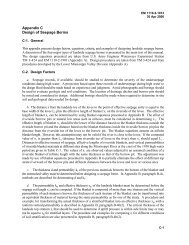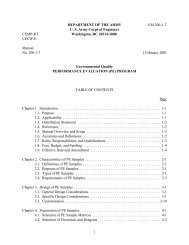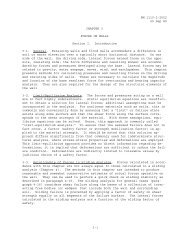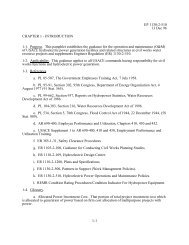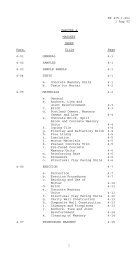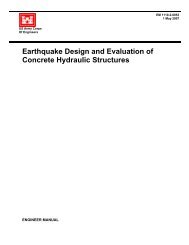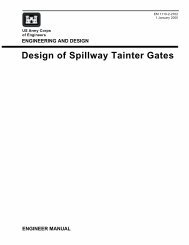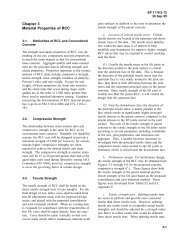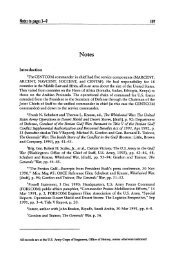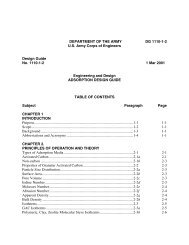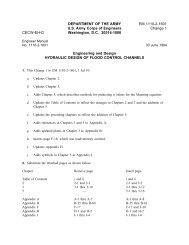Chapter 5 - Publications, US Army Corps of Engineers
Chapter 5 - Publications, US Army Corps of Engineers
Chapter 5 - Publications, US Army Corps of Engineers
You also want an ePaper? Increase the reach of your titles
YUMPU automatically turns print PDFs into web optimized ePapers that Google loves.
EM 1110-2-1701<br />
31 Dec 1985<br />
(4) The variation <strong>of</strong> efficiency with head can be quite<br />
significant at storage projects with large head ranges and at low-head<br />
run-<strong>of</strong>-river projects. %me sequential routing programs have<br />
provisions for modeling the variation <strong>of</strong> efficiency with head, and<br />
others can accommodatevariation with both head and discharge. Where<br />
only variation with head is ❑odeled, values <strong>of</strong> efficiency should be<br />
selected which are most representative <strong>of</strong> the discharge levels at<br />
which the plant will operate. When kW/cfs curves are used (see<br />
Appendix G), the variation <strong>of</strong> efficiency with head would be<br />
incorporated directly in that parameter. At other types <strong>of</strong> projects,<br />
the variation <strong>of</strong> efficiency with discharge can be an important<br />
consideration. Section 5-6k discusses the modeling <strong>of</strong> efficiency<br />
versus head and discharge in more detail.<br />
(1) Turbine selection is an iterative process, with preliminary<br />
power studies providing general information on approximate plant<br />
capacity, expected head range, and possibly an estimated design head.<br />
One or more preliminary turbine designs are then selected and their<br />
operating characteristics are provided as input for the more detailed<br />
power studies. The results <strong>of</strong> these studies make it possible to<br />
better identify the desired operating characteristics and thus permit<br />
final selection <strong>of</strong> the best turbine design and the best plant<br />
configuration (size and number <strong>of</strong> units).<br />
(2) Turbine performance data for various types <strong>of</strong> turbines is<br />
essential to the selection process. While data can be obtained<br />
directly from the manufacturer, it is recommended that field <strong>of</strong>fices<br />
work instead through one <strong>of</strong> the <strong>Corps</strong> Hydroelectric Design Centers.<br />
Hydraulic machinery specialists in these <strong>of</strong>fices have access to<br />
performance data for a wide range <strong>of</strong> unit designs from various<br />
manufacturers, and they are able to recommend runner designs that are<br />
best suited to any given situation. Performance curves can then be<br />
provided to the field <strong>of</strong>fice for the selected turbine design.<br />
(3) In preparing a request to a Hydroelectric Design Center for<br />
turbine selection, the following information should be provided.<br />
. expected head range<br />
. head-duration data (not required but very useful)<br />
● design head (optional)<br />
. total plant capacity (either hydraulic capacity in cfs or<br />
generator installed capacity in megawatts)<br />
● minimum discharge at which generation is desired<br />
. alternative combinations <strong>of</strong> size and number <strong>of</strong> units to be<br />
considered (optional)<br />
5-20




